Abstract
Transferable plasmids in gram-negative bacteria that confer resistance to potassium tellurite or tellurate were found. This re-istance was distinct from resistance to mercury, silver, or arsenic compounds and was unrelated to antibiotic resistance. In Escherichia coli, plasmids determine a 100-fold increase in the minimal inhibitory concentration for tellurite and a 10-fold increase in tellurate resistance. Many, but not all, of the plasmids belong to incompatibility group S. In Pseudomonas aeruginosa, tellurium resistance is specifically associated with incompatibility group P-2 and involves a 5- to 10-fold increase in tellurite or tellurate resistance.
Full text
PDF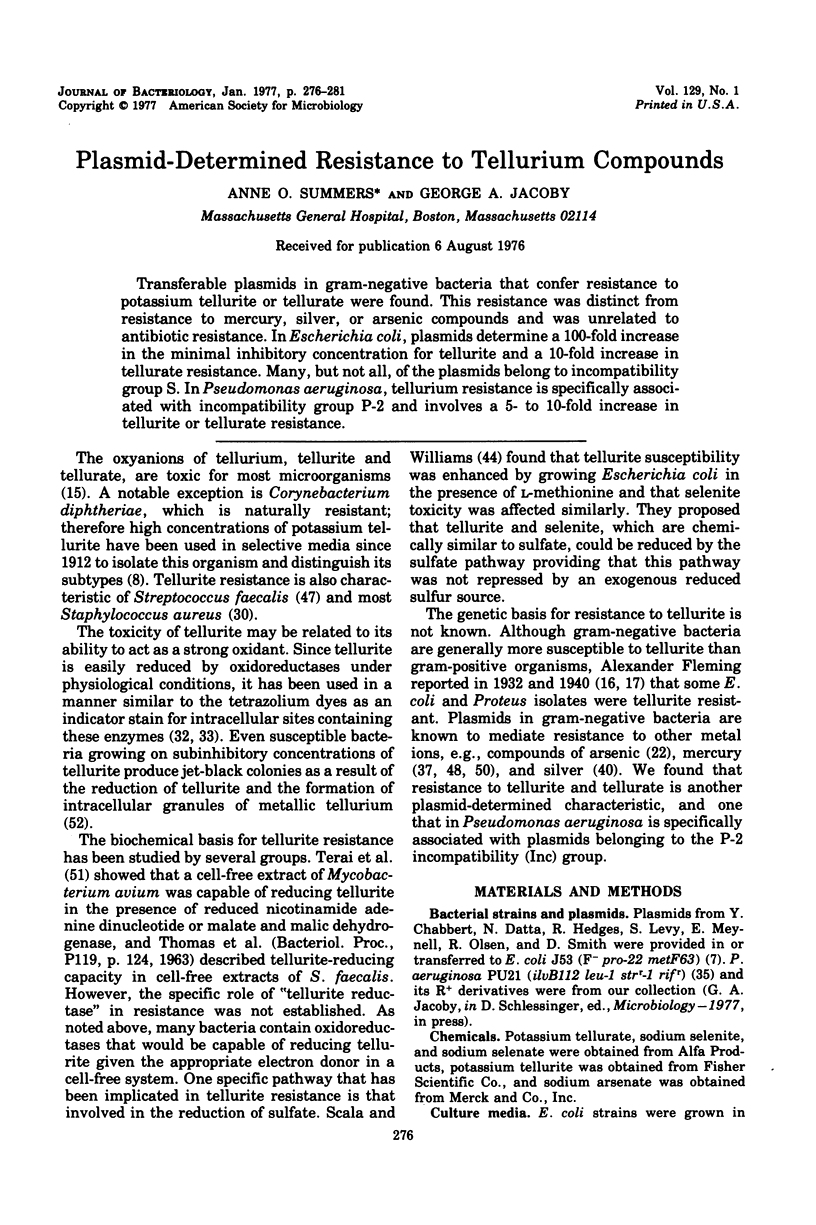
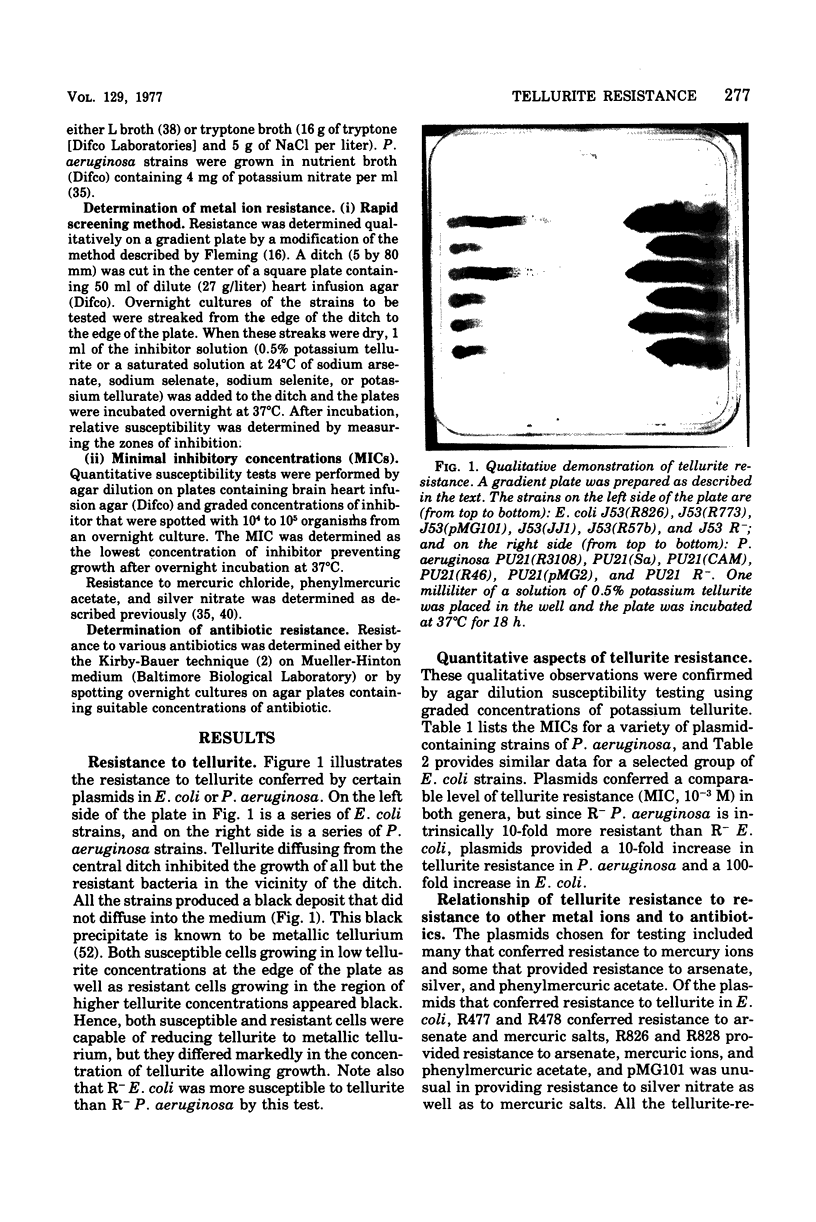
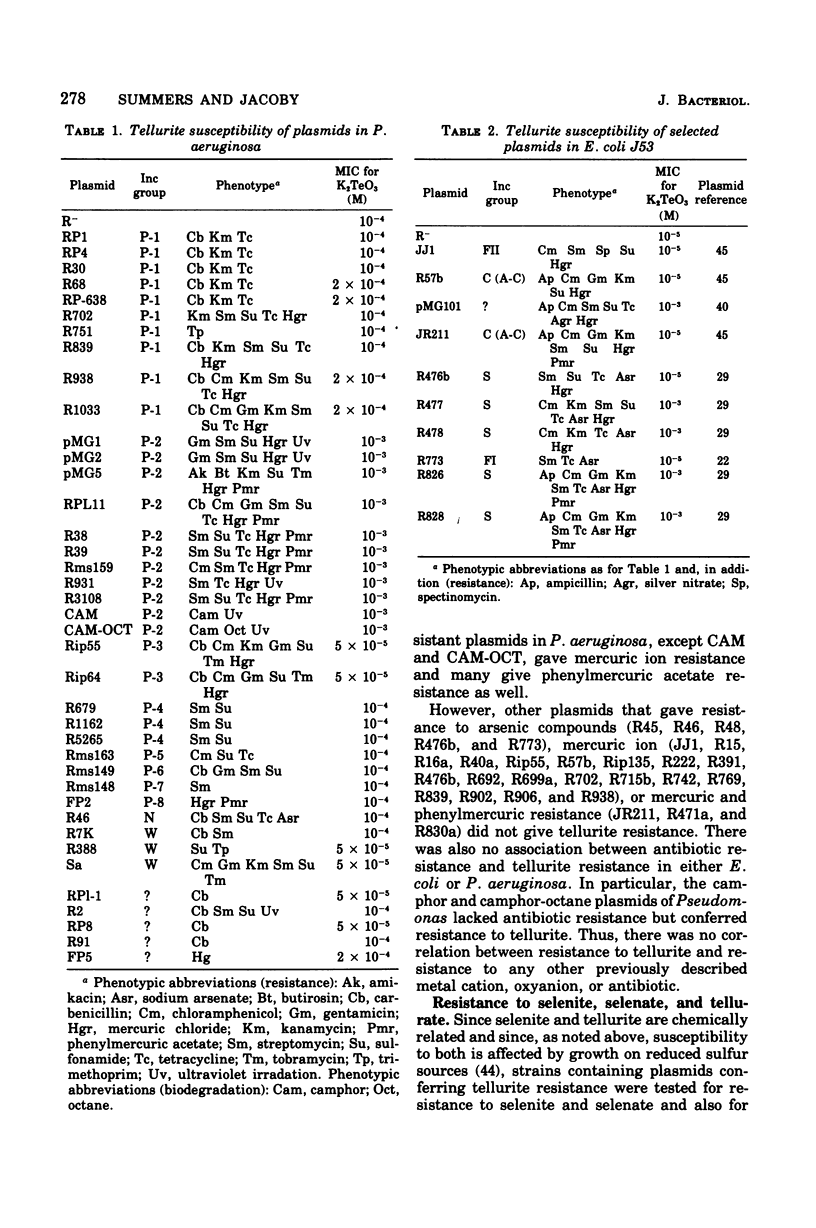
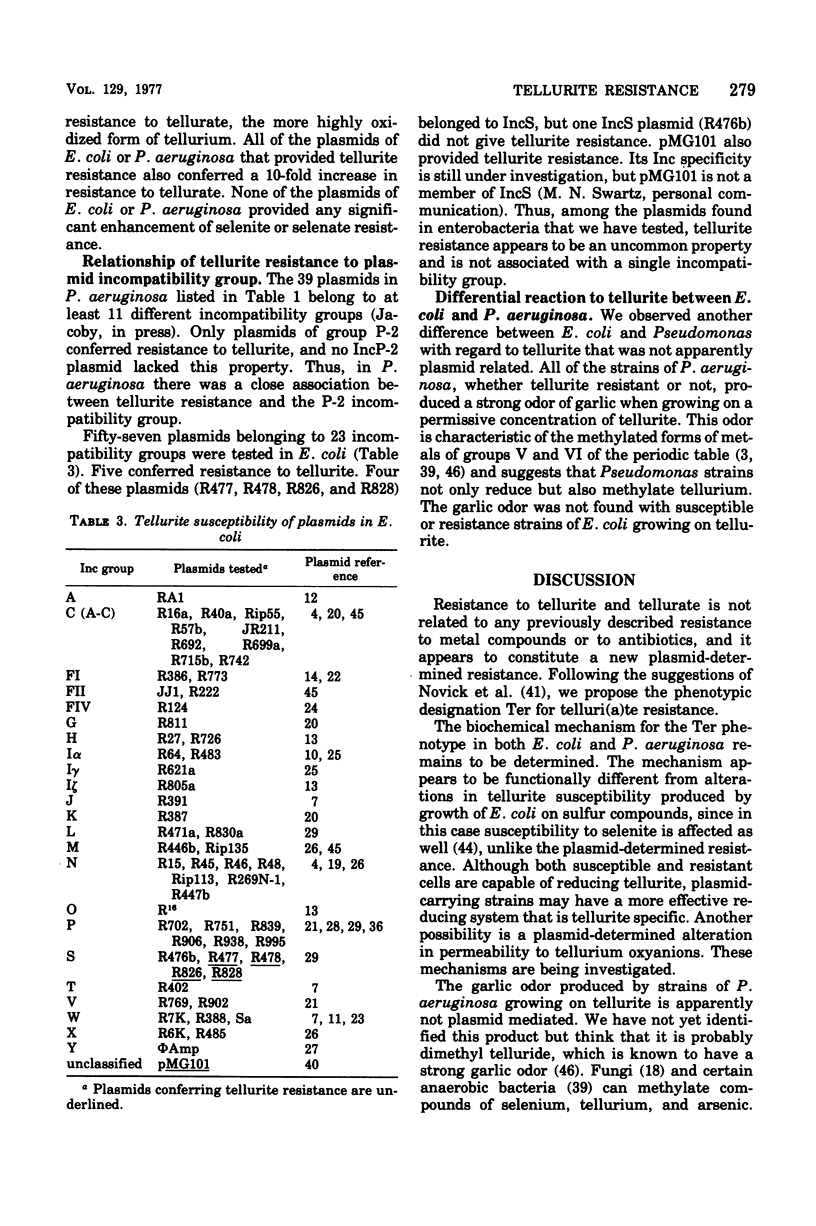

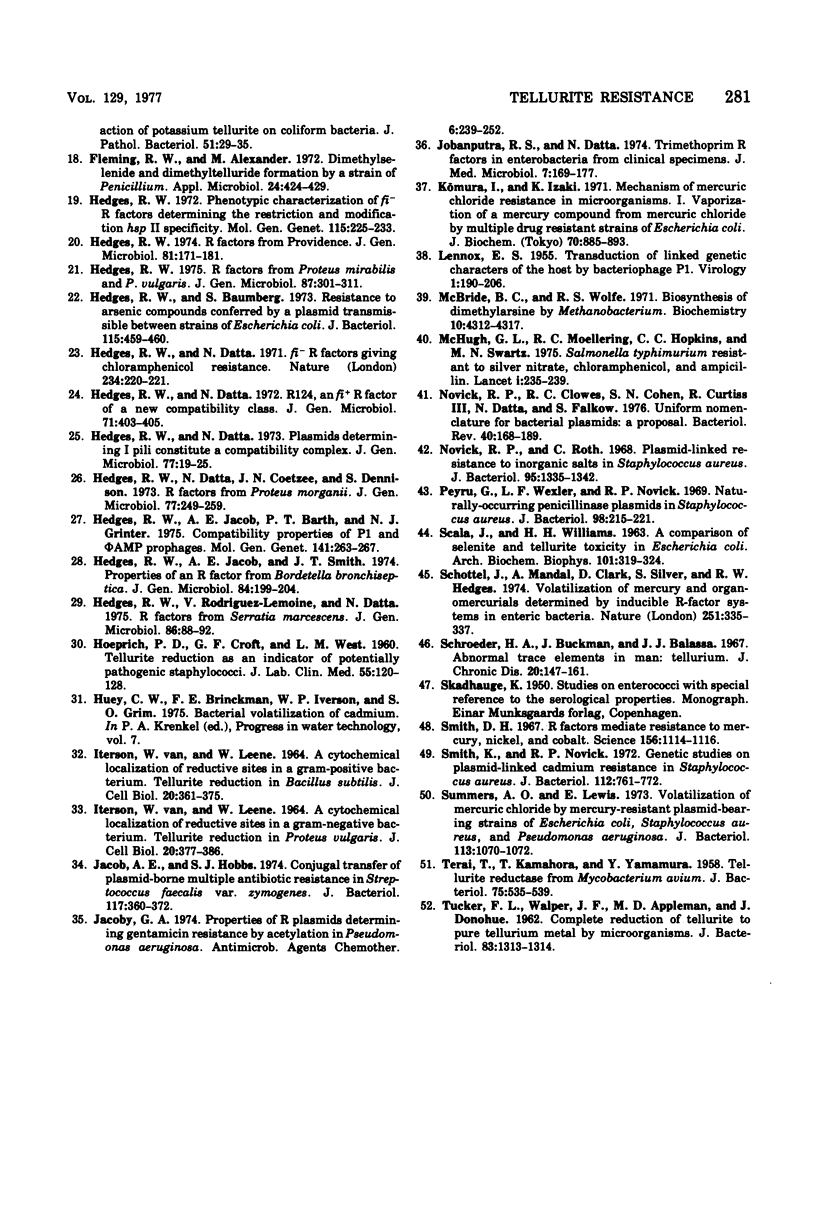
Images in this article
Selected References
These references are in PubMed. This may not be the complete list of references from this article.
- APPLEMAN M. D., HEINMILLER I. M. Comparison of tellurite resistance and tetracycline resistance among the enterococci. Appl Microbiol. 1961 Sep;9:391–394. doi: 10.1128/am.9.5.391-394.1961. [DOI] [PMC free article] [PubMed] [Google Scholar]
- Bauer A. W., Kirby W. M., Sherris J. C., Turck M. Antibiotic susceptibility testing by a standardized single disk method. Am J Clin Pathol. 1966 Apr;45(4):493–496. [PubMed] [Google Scholar]
- CERWENKA E. A., Jr, COOPER W. C. Toxicology of selenium and tellurium and their compounds. Arch Environ Health. 1961 Aug;3:189–200. doi: 10.1080/00039896.1961.10663003. [DOI] [PubMed] [Google Scholar]
- Chabbert Y. A., Scavizzi M. R., Witchitz J. L., Gerbaud G. R., Bouanchaud D. H. Incompatibility groups and the classification of fi - resistance factors. J Bacteriol. 1972 Nov;112(2):666–675. doi: 10.1128/jb.112.2.666-675.1972. [DOI] [PMC free article] [PubMed] [Google Scholar]
- Chau Y. K., Wong P. T., Silverberg B. A., Luxon P. L., Bengert G. A. Methylation of selenium in the aquatic environment. Science. 1976 Jun 11;192(4244):1130–1131. doi: 10.1126/science.192.4244.1130. [DOI] [PubMed] [Google Scholar]
- Clewell D. B., Yagi Y., Bauer B. Plasmid-determined tetracycline resistance in Streptococcus faecalis: evidence for gene amplification during growth in presence of tetracycline. Proc Natl Acad Sci U S A. 1975 May;72(5):1720–1724. doi: 10.1073/pnas.72.5.1720. [DOI] [PMC free article] [PubMed] [Google Scholar]
- Coetzee J. N., Datta N., Hedges R. W. R factors from Proteus rettgeri. J Gen Microbiol. 1972 Oct;72(3):543–552. doi: 10.1099/00221287-72-3-543. [DOI] [PubMed] [Google Scholar]
- Courvalin P. M., Carlier C., Chabbert Y. A. Plasmid-linked tetracycline and erythromycin resistance in group D "streptococcus". Ann Inst Pasteur (Paris) 1972 Dec;123(6):755–759. [PubMed] [Google Scholar]
- Datta N., Barth P. T. Compatibility properties of R483, a member of the I plasmid complex. J Bacteriol. 1976 Mar;125(3):796–799. doi: 10.1128/jb.125.3.796-799.1976. [DOI] [PMC free article] [PubMed] [Google Scholar]
- Datta N., Hedges R. W. R factors of compatibility group A. J Gen Microbiol. 1973 Feb;74(2):335–337. doi: 10.1099/00221287-74-2-335. [DOI] [PubMed] [Google Scholar]
- Datta N., Hedges R. W. Trimethoprim resistance conferred by W plasmids in Enterobacteriaceae. J Gen Microbiol. 1972 Sep;72(2):349–355. doi: 10.1099/00221287-72-2-349. [DOI] [PubMed] [Google Scholar]
- Datta N., Olarte J. R factors in strains of Salmonella typhi and Shigella dysenteriae 1 isolated during epidemics in Mexico: classification by compatibility. Antimicrob Agents Chemother. 1974 Mar;5(3):310–317. doi: 10.1128/aac.5.3.310. [DOI] [PMC free article] [PubMed] [Google Scholar]
- Dennison S. Naturally occurring R factor, derepressed for pilus synthesis, belonging to the same compatibility group as the sex factor F of Escherichia coli K-12. J Bacteriol. 1972 Jan;109(1):416–422. doi: 10.1128/jb.109.1.416-422.1972. [DOI] [PMC free article] [PubMed] [Google Scholar]
- Fleming R. W., Alexander M. Dimethylselenide and dimethyltelluride formation by a strain of Penicillium. Appl Microbiol. 1972 Sep;24(3):424–429. doi: 10.1128/am.24.3.424-429.1972. [DOI] [PMC free article] [PubMed] [Google Scholar]
- HOEPRICH P. D., CROFT G. F., WEST L. M., 2nd Tellurite reduction as an indicator of potentially pathogenic stapylococci. J Lab Clin Med. 1960 Jan;55:120–128. [PubMed] [Google Scholar]
- Hedges R. W., Baumberg S. Resistance to arsenic compounds conferred by a plasmid transmissible between strains of Escherichia coli. J Bacteriol. 1973 Jul;115(1):459–460. doi: 10.1128/jb.115.1.459-460.1973. [DOI] [PMC free article] [PubMed] [Google Scholar]
- Hedges R. W., Datta N., Coetzee J. N., Dennison S. R factors from Proteus morganii. J Gen Microbiol. 1973 Aug;77(2):249–259. doi: 10.1099/00221287-77-2-249. [DOI] [PubMed] [Google Scholar]
- Hedges R. W., Datta N. Plasmids determining I pili constitute a compatibility complex. J Gen Microbiol. 1973 Jul;77(1):19–25. doi: 10.1099/00221287-77-1-19. [DOI] [PubMed] [Google Scholar]
- Hedges R. W., Datta N. R124, an fi R factor of a new compatibility class. J Gen Microbiol. 1972 Jul;71(2):403–405. doi: 10.1099/00221287-71-2-403. [DOI] [PubMed] [Google Scholar]
- Hedges R. W., Jacob A. E., Barth P. T., Grinter N. J. Compatibility properties of P1 and PhiAMP prophages. Mol Gen Genet. 1975 Dec 1;141(3):263–267. doi: 10.1007/BF00341804. [DOI] [PubMed] [Google Scholar]
- Hedges R. W., Jacob A. E., Smith J. T. Properties of an R factor from Bordetella bronchiseptica. J Gen Microbiol. 1974 Sep;84(1):199–204. doi: 10.1099/00221287-84-1-199. [DOI] [PubMed] [Google Scholar]
- Hedges R. W. Phenotypic characterization of fi- R factors determining the restriction and modification hsp II specificity. Mol Gen Genet. 1972;115(3):225–233. doi: 10.1007/BF00268886. [DOI] [PubMed] [Google Scholar]
- Hedges R. W. R factors from Proteus mirabilis and P. vulgaris. J Gen Microbiol. 1975 Apr;87(2):301–311. doi: 10.1099/00221287-87-2-301. [DOI] [PubMed] [Google Scholar]
- Hedges R. W. R factors from Providence. J Gen Microbiol. 1974 Mar;81(1):171–181. doi: 10.1099/00221287-81-1-171. [DOI] [PubMed] [Google Scholar]
- Hedges R. W., Rodriguez-Lemoine V., Datta N. R factors from Serratia marcescens. J Gen Microbiol. 1975 Jan;86(1):88–92. doi: 10.1099/00221287-86-1-88. [DOI] [PubMed] [Google Scholar]
- Jacob A. E., Hobbs S. J. Conjugal transfer of plasmid-borne multiple antibiotic resistance in Streptococcus faecalis var. zymogenes. J Bacteriol. 1974 Feb;117(2):360–372. doi: 10.1128/jb.117.2.360-372.1974. [DOI] [PMC free article] [PubMed] [Google Scholar]
- Jacoby G. A. Properties of R plasmids determining gentamicin resistance by acetylation in Pseudomonas aeruginosa. Antimicrob Agents Chemother. 1974 Sep;6(3):239–252. doi: 10.1128/aac.6.3.239. [DOI] [PMC free article] [PubMed] [Google Scholar]
- Jobanputra R. S., Datta N. Trimethoprim R factors in enterobacteria from clinical specimens. J Med Microbiol. 1974 May;7(2):169–177. doi: 10.1099/00222615-7-2-169. [DOI] [PubMed] [Google Scholar]
- Komura I., Izaki K. Mechanism of mercuric chloride resistance in microorganisms. I. Vaporization of a mercury compound from mercuric chloride by multiple drug resistant strains of Escherichia coli. J Biochem. 1971 Dec;70(6):885–893. doi: 10.1093/oxfordjournals.jbchem.a129718. [DOI] [PubMed] [Google Scholar]
- LENNOX E. S. Transduction of linked genetic characters of the host by bacteriophage P1. Virology. 1955 Jul;1(2):190–206. doi: 10.1016/0042-6822(55)90016-7. [DOI] [PubMed] [Google Scholar]
- McBride B. C., Wolfe R. S. Biosynthesis of dimethylarsine by Methanobacterium. Biochemistry. 1971 Nov;10(23):4312–4317. doi: 10.1021/bi00799a024. [DOI] [PubMed] [Google Scholar]
- McHugh G. L., Moellering R. C., Hopkins C. C., Swartz M. N. Salmonella typhimurium resistant to silver nitrate, chloramphenicol, and ampicillin. Lancet. 1975 Feb 1;1(7901):235–240. doi: 10.1016/s0140-6736(75)91138-1. [DOI] [PubMed] [Google Scholar]
- Novick R. P., Clowes R. C., Cohen S. N., Curtiss R., 3rd, Datta N., Falkow S. Uniform nomenclature for bacterial plasmids: a proposal. Bacteriol Rev. 1976 Mar;40(1):168–189. doi: 10.1128/br.40.1.168-189.1976. [DOI] [PMC free article] [PubMed] [Google Scholar]
- Novick R. P., Roth C. Plasmid-linked resistance to inorganic salts in Staphylococcus aureus. J Bacteriol. 1968 Apr;95(4):1335–1342. doi: 10.1128/jb.95.4.1335-1342.1968. [DOI] [PMC free article] [PubMed] [Google Scholar]
- Peyru G., Wexler L. F., Novick R. P. Naturally occurring penicillinase plasmids in Staphylococcus aureus. J Bacteriol. 1969 Apr;98(1):215–221. doi: 10.1128/jb.98.1.215-221.1969. [DOI] [PMC free article] [PubMed] [Google Scholar]
- SCALA J., WILLIAMS H. H. A comparison of selenite and tellurite toxicity in Escherichia coli. Arch Biochem Biophys. 1963 May;101:319–324. doi: 10.1016/s0003-9861(63)80019-3. [DOI] [PubMed] [Google Scholar]
- Schottel J., Mandal A., Clark D., Silver S., Hedges R. W. Volatilisation of mercury and organomercurials determined by inducible R-factor systems in enteric bacteria. Nature. 1974 Sep 27;251(5473):335–337. doi: 10.1038/251335a0. [DOI] [PubMed] [Google Scholar]
- Schroeder H. A., Buckman J., Balassa J. J. Abnormal trace elements in man: tellurium. J Chronic Dis. 1967 Mar;20(3):147–161. doi: 10.1016/0021-9681(67)90049-5. [DOI] [PubMed] [Google Scholar]
- Smith D. H. R factors mediate resistance to mercury, nickel, and cobalt. Science. 1967 May 26;156(3778):1114–1116. doi: 10.1126/science.156.3778.1114. [DOI] [PubMed] [Google Scholar]
- Smith K., Novick R. P. Genetic studies on plasmid-linked cadmium resistance in Staphylococcus aureus. J Bacteriol. 1972 Nov;112(2):761–772. doi: 10.1128/jb.112.2.761-772.1972. [DOI] [PMC free article] [PubMed] [Google Scholar]
- Summers A. O., Lewis E. Volatilization of mercuric chloride by mercury-resistant plasmid-bearing strains of Escherichia coli, Staphylococcus aureus, and Pseudomonas aeruginosa. J Bacteriol. 1973 Feb;113(2):1070–1072. doi: 10.1128/jb.113.2.1070-1072.1973. [DOI] [PMC free article] [PubMed] [Google Scholar]
- TERAI T., KAMAHORA T., YAMAMURA Y. Tellurite reductase from Mycobacterium avium. J Bacteriol. 1958 May;75(5):535–539. doi: 10.1128/jb.75.5.535-539.1958. [DOI] [PMC free article] [PubMed] [Google Scholar]
- TUCKER F. L., WALPER J. F., APPLEMAN M. D., DONOHUE J. Complete reduction of tellurite to pure tellurium metal by microorganisms. J Bacteriol. 1962 Jun;83:1313–1314. doi: 10.1128/jb.83.6.1313-1314.1962. [DOI] [PMC free article] [PubMed] [Google Scholar]
- VAN ITERSON, LEENE W. A CYTOCHEMICAL LOCALIZATION OF REDUCTIVE SITES IN A GRAM-NEGATIVE BACTERIUM. TELLURITE REDUCTION IN PROTEUS VULGARIS. J Cell Biol. 1964 Mar;20:377–387. doi: 10.1083/jcb.20.3.377. [DOI] [PMC free article] [PubMed] [Google Scholar]
- VAN ITERSON, LEENE W. A CYTOCHEMICAL LOCALIZATION OF REDUCTIVE SITES IN A GRAM-POSITIVE BACTERIUM. TELLURITE REDUCTION IN BACILLUS SUBTILIS. J Cell Biol. 1964 Mar;20:361–375. doi: 10.1083/jcb.20.3.361. [DOI] [PMC free article] [PubMed] [Google Scholar]



